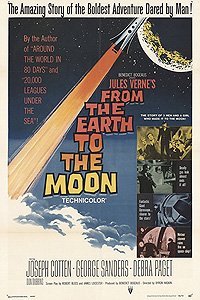From the Earth to the Moon |

USA • 1958 • 101m •
     • Directed by: Byron Haskin. • Starring: Joseph Cotten, George Sanders, Debra Paget, Don Dubbins, Patric Knowles, Carl Esmond, Henry Daniell, Melville Cooper, Ludwig Stössel, Morris Ankrum, Robert Clarke, Les Tremayne. • Music by: Louis Forbes. • Directed by: Byron Haskin. • Starring: Joseph Cotten, George Sanders, Debra Paget, Don Dubbins, Patric Knowles, Carl Esmond, Henry Daniell, Melville Cooper, Ludwig Stössel, Morris Ankrum, Robert Clarke, Les Tremayne. • Music by: Louis Forbes.     Set just after the American civil war, businessman and inventor Victor Barbicane invents a new source of power called Power X. He plans to use it to power rockets, and to show its potential he plans to send a projectile to the moon. Joining him for the trip are his assistant Ben Sharpe, Barbicane's arch-rival Stuyvesant Nicholl, and Nicholl's daughter Virginia. Nicholl believes that Power X goes against the will of God and sabotages the projectile so that they cannot return to earth, setting up a suspenseful finale as they battle to repair the projectile. Set just after the American civil war, businessman and inventor Victor Barbicane invents a new source of power called Power X. He plans to use it to power rockets, and to show its potential he plans to send a projectile to the moon. Joining him for the trip are his assistant Ben Sharpe, Barbicane's arch-rival Stuyvesant Nicholl, and Nicholl's daughter Virginia. Nicholl believes that Power X goes against the will of God and sabotages the projectile so that they cannot return to earth, setting up a suspenseful finale as they battle to repair the projectile.
|
Trailers:
| Length: | Languages: | Subtitles: |
Review:











So in the novel, the Baltimore Gun Club members are all leading engineers who helped the Northern cause by building better guns and cannon. Most of them are missing limbs as a result. The President of the club, J.P. Barbicane (in some versions his name is "Impey" Barbicane) has his limbs. His closest associate, the club's secretary, J.T. Maston, has most of his body, but has one hook for a hand. They are the only members with "in tact" bodies. The club is seeking something to do with it's time, after the Confederacy collapses. Barbicane suggests building the "Columbiad" (which, by the way, is the cannon, not the projectile) to travel or communicate with the moon. The plan is barely presented when Maston suggests using the cannon instead to annex Mexico! See - Verne has our bellicosity down quite pat.
Barbicane has a wartime rival, one Captain Nicholl. Nicholl specialized in better and better armor. Barbicane specialized in better and better shells to pierce the armor. Nicholl will soon become the leading critic of the scheme.
Verne (in real life) was a friend of the prominent aeronaut and photographer, Nadar. Nadar became the model for the French adventurer Michel Ardan (note the anagram last name for "Nadar") who proposes traveling in the projectile to the moon. Barbicane and Nicholl end up joining him (while Maston will be in charge of carefully following their travel by powerful telescope). The flight actually had great accuracy in detailing the length of the trip (four days) and in showing the amazing effect of weightlessness (Verne noted that by leaving the gravity field of earth this would result). The capsule never lands on the moon (it couldn't, because if it had it would not have been capable of getting back. Verne explains that there is a miscalculation in the calculations of the trajectory. This enables the moon to help send the capsule back to earth.
NadarArdan is not in the movie. Nicholl does not become so completely involved and willing to work with Barbicane as the novel shows. George Sanders' Stuyvesant Nicholl ("Stuyvesant"?) remains hostile to Joseph Cotton's Victor Barbicane (what happened to "Impey") up to a few minutes before the conclusion. There is no power X in the novel - no new energy source. The movie was made in the 1950s, so the public had to think that Verne was thinking in terms of atomic power. Actually he never did. There is no romance between the children of Sanders and Cotton. These changes in the film help weaken the film in comparison to the novel (which still reads well - try to get the translation by Walter Miller that is the best in English).
This was not the only film version of the novel. The classic early film by George Melies, A TRIP TO THE MOON, has a period charm that makes one forget it's cardboard backgrounds (and it's projectile in the eye of the man in the moon is a classic moment of cinema). And then there was the film ROCKET TO THE MOON which turned the story into an all-star comedy with Burl Ives, Terry-Thomas, Lionel Jeffries, and Dennis Price.
Verne was not finished with his travelers either, after AROUND THE MOON. In 1889 he wrote THE PURCHASE OF THE NORTH POLE, where the Gun Club decides to use the Columbiad to alter the tilt of the globe. Ardan does not reappear, but Barbicane, Nicholl, and Marston do. It is not as good a novel as the first two.
Review by theowinthrop from the Internet Movie Database.
Movie Database